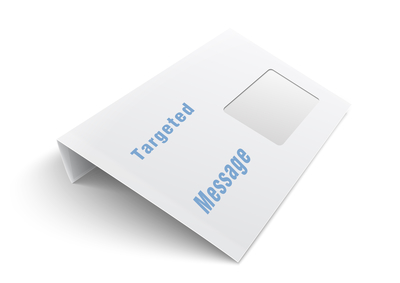Could it be that we stand on the cusp of great change in the world of direct mail envelopes? Digital colour, personalisation and the ‘white paper factory’ concept all point towards a new role for the humble envelope.
Full colour digital printing has given rise to the concept of printing targeted marketing messages on the outside of the envelope, such that will grab the recipient’s attention and make them want to open it. A new breed of production machines is able to take a printed reel of paper and create the letter, the envelope and possibly even other inserts, automatically. There is even the possibility that the window envelope may one day become a thing of the past.
What can be said for certain already is that current digital printing technologies open up the potential even for small printing companies to offer their customers short runs of high quality printed envelopes that, with a little daring on behalf of the marketing community, could carry bold marketing messages and other devices to intrigue the consumer and avoid the familiar fate of much direct mail of going straight into the bin.
‘People are looking at customised envelopes, personalisation on envelopes, even just for a wedding invitation,’ said Mark Baker Homes of Intec Printing Solutions. ‘You can start getting your marketing messages across, and there’s more of a chance that the envelope will get opened. People are trying to work out how to make their product different.’
This is an idea that has already gained considerable traction in the US, according to John Ricketts, Pitney Bowes UK’s sales director, but has been embraced less in the UK thus far. ‘Our marketing departments are a little more conservative and they want to do test runs to see what the reaction is,’ he said. ‘It’s a big opportunity and I think it will grab some space – probably more with telcos and utilities than with the banks. We are doing some piloting and getting positive feedback.’
Pete Jolley, general manager at Kern UK, points out that this practice could open an interesting debate in this country however. ‘Printing on the envelope in full colour or mono is a great tool and technically very clever. We believe that to be critical in terms of quality. Equally, it is also about how companies use data. There is an argument that if a piece of mail comes through the door and there is a lot of personal stuff on the outside of the envelope, you are beginning to cross a line. You don’t necessarily want it to say ‘Happy 50th Birthday’ on the envelope. For some people, that oversteps the mark.’
Whether that takes off or not, for mailing house TPG Direct it is about economics. It has recently bought a four colour envelope printer from AMS. Managing partner Lincoln Hillan explained: ‘To do 20% coverage on a C5 envelope we are talking about £3.50 a thousand cost to me. If I go to an envelope printer I will pay them at least £30 to £40 a thousand. For small runs, envelope providers tend to charge a lot of money. We’ve already got some customers very interested. We’re trying to get into car dealerships for variable imagery, solicitors and accountants for their stationery and branded envelopes. Is colour important? In some respects yes, and it will allow us to offer cost effective envelope printing in short runs. It becomes more relevant and people will buy into that.’
There are numerous options when it comes to technology, and the choice will of course depend much upon volumes and applications. Intec has a range of envelope printing systems, from compact up to a heavy duty system suited for companies printing up to 200,000 envelopes per month.
Its digital engines have a flat paper path, so the envelope is much less likely to hit a snag on its journey through, and it has a range of envelope feeders designed to be integrated or even just rolled up to the print systems.
Its latest is the Professional Envelope Feeder EPP550 system, which can wheeled up to or away from the Intec XP2020 printer. At the higher end come the ‘White Paper Factory’ systems from Pitney Bowes, while Kern also produces machines that can make the envelope on the fly from a reel of paper.
There have been problems with reversions before, where Royal Mail has rejected a batch of mail because addresses failed to match up with the window on the envelope. Could this, combined with the availability of technology as described above, lead to the demise of the window envelope?
Potentially, according to John Ricketts. ‘The financial companies are a little risk averse and they feel comfortable with window envelopes, but the technology is there to eliminate window envelopes eventually. As soon as a couple of the large companies change, then it will become more acceptable in the market place.





